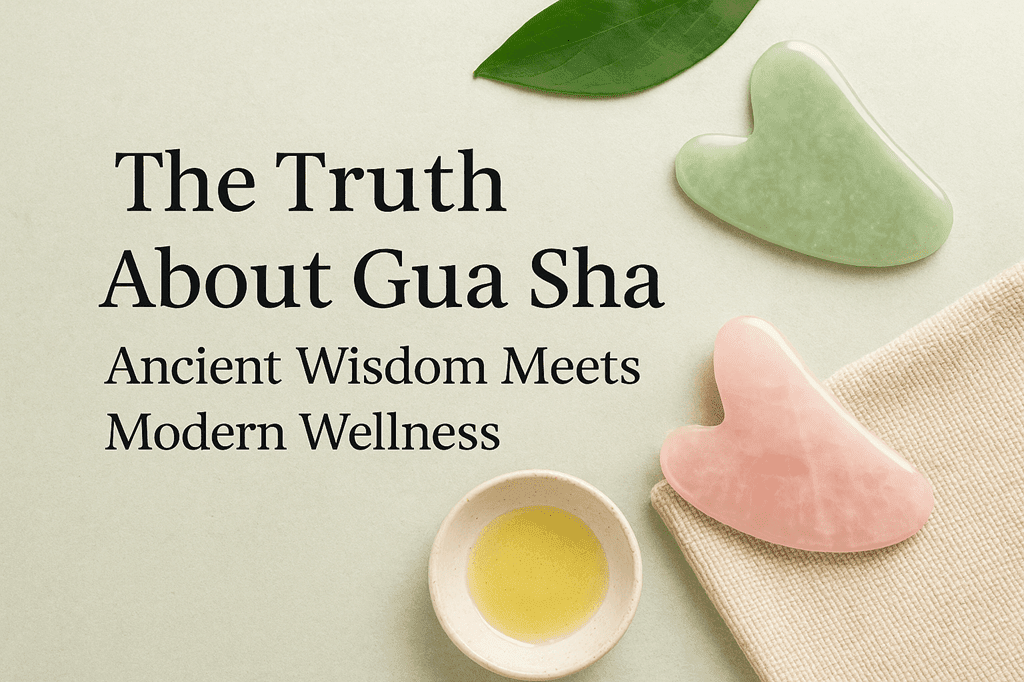
In recent years, gua sha has made a huge comeback — not just in traditional Chinese clinics, but across beauty studios, wellness centers, and social media. Videos of smooth jade tools gliding over the skin, promising relaxation, detox, or even a “natural facelift,” have gone viral worldwide.
But what exactly is gua sha?
Does it really work — or is it just another wellness trend?
And, most importantly, how can you use it safely and effectively?
Let’s explore what science and tradition both say about this ancient healing art.
1. What Is Gua Sha?
From Ancient Remedy to Modern Ritual
Gua sha (pronounced gwa-shah) literally means “scraping sand,” referring to the small reddish marks that appear on the skin after gentle scraping. It originated in Traditional Chinese Medicine (TCM) centuries ago as a household remedy to “release stagnation,” “promote circulation,” and restore balance in the body.
Traditional View
In TCM theory, gua sha stimulates the meridians and activates qi and blood flow, helping the body clear “internal heat” and relieve discomfort.
Modern Scientific View
Recent studies suggest a more physiological explanation:
- Improves microcirculation: Gua sha increases local blood flow and oxygen exchange.
- Relieves muscle tension: The scraping motion relaxes tight fascia and muscles.
- Reduces inflammation: Some research shows decreased inflammatory markers after gua sha.
- Promotes pain relief: Trials show short-term pain reduction in neck, shoulder, and back muscles.
💡 In simple terms: gua sha helps muscles relax and blood flow improve — which can make your body feel lighter, looser, and more comfortable.
2. What Are the Real Benefits of Gua Sha?
With so many claims floating around, it’s worth separating the facts from the hype.
| Claimed Benefit | What Research Says | Verdict |
|---|---|---|
| Relieves neck, shoulder, or back pain | Supported by multiple clinical studies | ✅ Effective |
| Improves blood circulation and lymphatic flow | Observed in imaging and lab studies | ✅ Likely |
| Reduces stress and improves sleep | Based on relaxation response, not direct proof | ⚪ Possible |
| Lifts face and reduces puffiness | May temporarily boost circulation | ⚪ Temporary |
| Detoxifies the body or burns fat | No scientific evidence | ❌ Myth |
So yes — gua sha works, but mainly for muscle relaxation, circulation, and stress relief, not dramatic “detox” or “slimming” results.
3. The Rise of Smart Gua Sha Devices
When Technology Meets Tradition
The ancient scraping tool has now entered the tech age.
Today’s electric gua sha devices combine traditional massage with features like:
- Warm heating
- Gentle vibration
- Adjustable suction or negative pressure
- Auto-timers and safety sensors
These smart tools offer a convenient, beginner-friendly way to experience gua sha at home — perfect for modern lifestyles.
However, use them carefully:
Avoid excessive heat or strong suction, and always apply a massage oil or serum to protect your skin.
💡 Pro tip: Start on the lowest setting and limit each area to 3–5 minutes.
4. How to Do Gua Sha Safely at Home
What You Need
- A smooth-edged gua sha board (jade, quartz, obsidian, or stainless steel)
- Facial oil or body massage oil (to reduce friction)
- Clean, relaxed skin
Step-by-Step Guide
- Warm up — sit comfortably and relax your muscles.
- Apply oil — to create a protective layer on the skin.
- Scrape gently — follow natural lines: from neck upward, from center to sides on the face, or from top to bottom on the back.
- Adjust pressure — light to medium; discomfort means you’re pressing too hard.
- Duration — 10–15 minutes per session, 1–2 times per week is enough.
Common Mistakes to Avoid
🚫 Thinking “the more redness, the better”
🚫 Using gua sha when you have fever or open wounds
🚫 Doing it every day without rest
Who Should Avoid Gua Sha
- People with bleeding disorders or on blood thinners
- Pregnant women (especially abdominal area)
- Individuals with skin infections or serious heart conditions
5. Myths, Misconceptions, and the Scientific Debate
Gua sha’s popularity has also led to misunderstandings — especially online.
-
Myth 1: “More bruises mean more toxins released.”
→ False. The redness (“sha”) is simply blood capillaries expanding — not toxins leaving the body. -
Myth 2: “Facial gua sha can reshape your face.”
→ Unlikely. It can reduce puffiness or tension, but it doesn’t melt fat or change bone structure. -
Myth 3: “You can do gua sha anytime, anywhere.”
→ Wrong. Timing, direction, and moderation matter; otherwise it may irritate the skin or cause dizziness.
Medical professionals now view gua sha as a complementary therapy — helpful for relaxation and pain management, but not a replacement for medical treatment.
6. The Modern View: Balance Between Tradition and Science
Today, gua sha stands at a fascinating crossroads — blending ancient healing philosophy with modern research and technology.
Scientists continue to study its effects on:
- Inflammatory markers (like IL-6 and TNF-α)
- Microcirculation imaging
- Pain modulation and immune response
At the same time, health-conscious consumers use it as a self-care ritual — a mindful moment of body awareness and stress relief in an overstimulated world.
7. Conclusion: Gentle Hands, Balanced Mind
Gua sha isn’t magic, nor is it a myth.
It’s a time-tested technique that can help you relax, ease muscle tension, and reconnect with your body — when used correctly and moderately.
So the next time you pick up your jade or quartz tool, remember:
You’re not just scraping your skin — you’re reviving a centuries-old wellness practice, one mindful stroke at a time.
✨ True beauty and health come not from force, but from balance.

